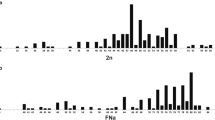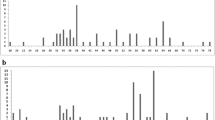Abstract
A comprehensive karyological characterization of 20 Australian and three European species of Isoptera, together with a mitochondrial gene analysis is presented. Higher termites appear karyotypically very uniform, while lower termites are highly variable. The differences in chromosome number are explained through Robertsonian changes or multiple translocation events. An ancestral acrocentric karyotype can be suggested as the most primitive one. In Kalotermitidae chromosomal repatterning has repeatedly arisen with the X0-male type possibly representing a XY-derived condition. This argues against a simple origin of termites from cockroaches. The fixed chromosome number of Rhinotermitidae and Termitidae (2n=42, XY/XX) may be explained with the non-random nature of chromosomal evolution. A sex-linked multivalent, either with a ring or a chain structure, is found in the majority of species. Phylogenetic analyses on COII sequences recognize Mastotermitidae as the basal lineage and define the Rhinotermitidae + Termitidae cluster with a good bootstrap support. Kalotermitidae fail to be joined in a single cluster in agreement with the detected chromosomal variability. On the other hand, the karyotypic conservation of the Termitidae family contrasts with the polytomy evidenced at the subfamily level.
Similar content being viewed by others
References
Ahmad M (1950) The phylogeny of termite genera based on imago-worker mandibles. Bull Am Mus Nat Hist 95: 39–86.
Austin JW, Szalanski AL, Cabrera BJ (2004) Phylogenetic analysis of the subterranean termite family rhinotermitidae (Isoptera) by using the mitochondrial cytochrome oxidase II gene. Ann Entomol Soc Am 97: 548–555.
Barlow BA, Wiens D, Wiens C, Busby WH, Brighton C (1978) Permanent translocation heterozigosity in Viscum album and V. cruciatum: sex association, balance lethals, sex ratio. Heredity 40: 33–38.
Bartz SJ (1979) Evolution of eusociality in termites. Proc Natl Acad Sci USA 76: 5764–5768.
Bedo DG (1987) Undifferentiated sex chromosomes in Mastotermes darwiniensis Froggatt (Isoptera, Mastotermitidae) and the evolution of eusociality in termites. Genome 29: 76–79.
Bick Y, Sharman G (1975) The chromosomes of the platypus (Ornithorhynchus): Monotrema. Cytobios 14: 17–28.
Bulmer MS, Crozier RH (2004) Duplication and diversifying among termite antifungal peptides. Mol Biol Evol 21: 2256–2264.
Bull JJ (1983) Evolution of Sex Determining Mechanisms. Benjamin/Cummings: Menlo Park, CA
Cleland RE (1972) Oenothera, Cytogenetics and Evolution. New York: Academic Press.
Clèment JL (1977) Carytypes des Reticulitermes francais. CR Acad Sci Paris 284: 2355–2356.
Crozier RH, Luykx P (1985) The evolution of termite eusociality is unlikely to have been based on a male-haploid analogy. Am Naturalist 126: 867–869.
Donovan SE, Jones DT, Sands WA, Eggleton P (2000) Morphological phylogenetics of termites (Isoptera). Biol J Linn Soc 70: 467–513.
Doyle JJ, Doyle JL (1987) A rapid DNA isolation method for small quantities of fresh tissues. Phytochem Bull 19: 11–15.
Eggleton P (2001) Termites and trees: a review of recent advances in termite phylogenetics. Insect Soc 48: 187–193.
Emerson AE, Krishna K (1975) The termite family Serritermitidae (Isoptera). Am Mus Novitates 2570: 1–31.
Engel MS, Krishna K (2004) Family-group names for termites (Isoptera). Am Mus Nat Hist 3432: 1–9.
Fontana F (1980) Interchange complexes in Italian populations of Reticulitermes lucifugus Rossi (Isoptera: Rhinotermitidae). Chromosoma 81: 169–175.
Fontana F (1982) Cytological analysis of the chromosome complement of Kalotermes flavicollis Fabr. (Isoptera Kalotermitidae). The sex determining mechanism. Cytologia 47: 147–152.
Fontana F (1991) Multiple reciprocal chromosomal translocations and their role in the evolution of sociality in termites. Ethol Ecol Evol 1: 15–19.
Grassè PP (1986) Termitologia Vol.III Masson: Paris
Gruetzner F, Ashley T, Rowell D, Marshall Graves JA (2006) How did the platypus gets its sex chromosome chain? A comparison of meiotic multiples and sex chromosomes in plants and animals. Chromosoma 115: 75–88.
Gruetzner F, Rens W, Tsend-Ayush E et al. (2004) In the platypus a meiotic chain of ten sex chromosomes shares genes with the bird Z and mammal X chromosomes. Nature 432: 913–917.
Hill GF (1942) Termites (Isoptera) from the Australian Region. Melbourne: CSIR.
Kambhampati S, Eggleton P (2000) Phylogenetics and taxonomy. In: Abe T, Higashi M, Bignell DE, eds. Terminates: Evolution, Sociality, Symbiosis, Ecology. Dordrecht: Kluwer Academic Publishing, pp. 1–23.
Kambhampati S, Kjer KM, Thorne BL (1996) Phylogenetic relationship among termite families based on DNA sequence of mitochondrial 16S ribosomal RNA gene. Insect Mol Biol 5: 229–238.
King M (1993) Species Evolution: the Role of Chromosome Changes. Cambridge, UK: Cambridge University Press.
Kjer KM (2004) Aligned 18S and insect phylogeny. Syst Biol 53(3): 506–514.
Kràl J, Musilova J, St’àhlavsky F et al. (2006) Evolution of the karyotype and sex chromosome system in basal clades of araneomorph spiders (Araneae: Araneomorphae). Chromosome Res 14: 859–880.
Krishna K (1970) Taxonomy, phylogeny and distribution of termites. In: Krishna K, Weesner FM eds. Biology of Termites. New York: Academic Press, pp. 127–152.
Kumar S, Tamura K, Nei M (2004) MEGA3: Integrated software for molecular evolutionary genetics analysis and sequence alignment. Briefings Bioinformat 5: 150–163.
Lacy RC (1980) The evolution of eusociality in termites: a haplo-diploid analogy? Am Nat 116: 449–451.
Levan A, Fredga K, Sandberg AA (1964) Nomenclature for centromeric position on chromosomes. Hereditas 52: 201–220.
Liu H, Beckenbach AT (1992) Evolution of the mitochondrial cytocrome oxidase II gene among 10 orders of insects. Mol Phylogenet Evol 1: 41–52.
Lo N, Bandi C, Watanabe H et al. (2003) Evidence for cocladogenesis between diverse dictyopteran lineages and their intracellular endosymbionts. Mol Biol Evol 20: 907–913.
Lo N, Eldrige RH, Lenz M (2006a) Phylogeny of Australian Coptotermes (Isoptera: Rhinotermitidae) species inferred from mitochondrial COII sequences. Bull Entomol Res 96: 433–437.
Lo N, Luykx P, Santoni R et al. (2006b) Molecular phylogeny of Cryptocercus wood-roaches based on mitochondrial COII and 16S sequences, and chromosome numbers in palearctic representatives. Zool Sci 23: 393–398.
Lo N, Tokuda G, Watanabe H et al. (2000) Evidence for multiple gene sequences indicates that terminates evolved from wood-feeding cockroaches. Curr Biol 10: 801–804.
Luykx P (1990) A cytogenetic survey of 25 species of lower termites from Australia. Genetica 33: 80–88.
Luykx P, Syren RM (1979) Thecytogenetics of Incisitermes schwarzi and other Florida terminates. Sociobiology.
Macaisne N, Dutrillaux AM, Dutrillaux B (2006) Meiotic behaviour of a new complex X-Y-autosome translocation and amplified heterochromatin in Jumnos ruckeri (Saunders) (Coleoptera, Scarabaeidae, Cetoniinae). Chromosome Res 14: 909–918.
Miller LR (1991) A revision of the Termes–Capritermes branch of the Termitinae in Australia (Isoptera: Termitidae). Invertebr Taxon 4: 1147–1282.
Miller LR (1997) Systematic of the Australian Nasutitermitinae with reference to evolution within the Termitidae (Isoptera). Ph.D. thesis, Australian National University, Canberra, Australia.
Miura T, Maekawa K, Kitade O, Abe T, Matsumoto T (1998) Phylogenetic relationship among subfamilies in higher termites (Isoptera: Termitidae) based on mitochondrial COII gene sequences. Ann Entomol Soc Am 91: 515–523.
Miura T, Roisin Y, Matsumoto T (2000) Molecular phylogeny and biogeography on the Nasute Termite Genus Nasutitermes (Isoptera: Termitidae) in the Pacific tropics. Mol Phylogenet Evol 17: 1–10.
Noirot C (1995) The gut of termites (Isoptera). Comparative anatomy, systematics, phylogeny, lower termites. Annals de la Societè Entomologique de France 31: 197–226.
Ogawa K (1954) Chromosome studies in the Myriapoda. VII. A chain-association of the multiple sex chromosomes found in Otocryptos sexspinosus (Say). Cytologia 19: 265–272.
Ohkuma M, Yuzawa H, Amornsak W et al. (2004) Molecular phylogeny of Asian Termites (Isoptera) of the families Termitidae and Rhinotermitidae based on mitochondrial COII sequences. Mol Phylogenet Evol 31: 701–710.
Ozeki M, Isagi Y, Tsubota H, Jacklyn P, Bowman D (2007) Phylogeography of an Australian termite, Amitermes laurensis (Isoptera, Termitidae), with special reference to the variety of mound shapes. Mol Phylogenet Evol 42: 236–247.
Posada D, Crandall KA (1998) Modeltest: testing the model of DNA substitution. Bioinformatics 14: 817–818.
Rowell D (1985) Complex sex-linked fusion heterozigosity in the Australian huntsman spider Delena cancerides (Aranea: Sparassidae). Chromosoma 93: 169–176.
Rowell DM (1986) Complex sex-linked translocation heterozygosity and its role in the evolution of social behaviour. Can J Genet Cytol 28: 168–170.
Santos O, Luykx P (1985) Holozigosity for sex-linked genes in males of the termite Incisitermes schwarzi. Biochem Genet 23: 729–739.
Schneeweiss GM, Palomeque T, Colwell AE, Weiss-Shneeweiss H (2004) Chromosome numbers and karyotype evolution in holoparasitic Orobanche (Orobanchaceae) and related genera. Am J Bot 91: 439–448.
Shimodaira H, Hasegawa M (1999) Multiple comparison of log-likelihoods with application to phylogenetics inference. Mol Biol Evol 16: 1114–1116.
Simon C, Frati F, Beckenbach A, Crespi B, Liu H, Flook P (1994) Evolution, weighting and phylogenetic utility of mitochondrial genes sequences and a compilation of conserved polymerase chain reaction primers. Ann Entomol Soc Am 87: 651–701.
Swofford DL (2001) PAUP*-Phylogenetics Analysis Using Parsimony (* and Other Methods), Ver. 4b. Sunderland, Massachusetts: Sinauer Associates.
Syren RM, Luykx P (1977) Permanent segmental interchange complex in the termite Incisitermes schwarzi. Nature 266: 167–168.
Syren RM, Luykx P (1981) Geographic variation of sex-linked translocation heterozigosity in the termite Kalotermes approximates Snyder (Insecta, Isoptera). Chromosoma 82: 65–88.
Thompson GJ, Miller LR, Lenz M, Crozier RH (2000) Phylogenetic analysis and trait evolution in Australian lineages of drywood termites (Isoptera, Kalotermitidae). Mol Phylogenet Evol 17: 419–429.
Thorne BL, Carpenter JM (1992) Phylogeny of the Dictyoptera. Syst Entomol 17: 253–268.
Thorne BL, Breisch NL, Muscedere ML (2003) Evolution of eusociality and the soldier caste in termites: influence of intraspecific competition and accelerated inheritance. PNAS 100(22): 12808–12813.
Vincke PP, Tilquin P (1978) A sex-linkedring quadrivalent in Termitidae (Isoptera). Chromosoma 67: 151–156.
Watson JAL, Abbey HM (1993) Atlas of Australian Termites. Melbourne, Australia: CSIRO Publishing.
Wrigley JM, Graves JAM (1988) Karyotypic conservation in the mammalian order Monotremata (subclass Prototheria). Chromosoma 96: 231–247.
Zompro O (2005) Inter- and intra-ordinal relationships of the Mantophasmatodea, with comments on the phylogeny of polyneopteran orders (Insecta: Polyneoptera). Mitt Geol-Paläontol Inst Univ Hamburg Heft 89: 85–116.
Author information
Authors and Affiliations
Corresponding author
Electronic Supplementary Material
Below is the link to the electronic supplementary material.
About this article
Cite this article
Bergamaschi, S., Dawes-Gromadzki, T.Z., Scali, V. et al. Karyology, mitochondrial DNA and the phylogeny of Australian termites. Chromosome Res 15, 735–753 (2007). https://doi.org/10.1007/s10577-007-1158-6
Received:
Revised:
Accepted:
Published:
Issue Date:
DOI: https://doi.org/10.1007/s10577-007-1158-6




